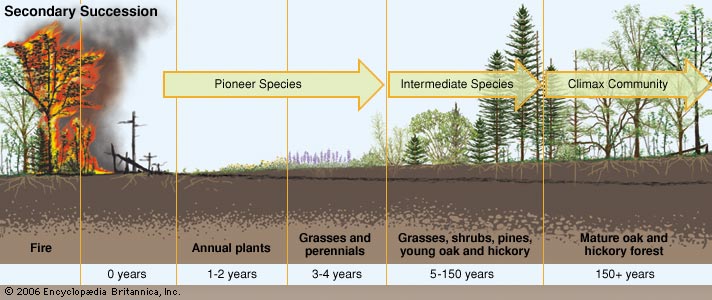Section 5: Ecological Succession
A community is made up of populations that live in a common area. A community includes the type of species, the number of species, their feeding relationship, and the interactions among species.
Changes that often occur in ecosystems are called disturbances, which affect populations and communities. A limiting factor limits an organism’s ability to live in a particular environment. For example, a lack of water causes grass to die, which causes certain herd populations that rely on that grass to decrease. Tolerance is the ability of living things to survive the changes in their environment. The more tolerant a species is, the better its chances of survival.
Succession is the process of gradual, natural change and species replacement that takes place in the communities of an ecosystem over time. Primary succession begins on land where there are no living organisms. For example, after a volcanic eruption, the land is primarily bare for three to five years until lichens, moss, and small pioneer species of plants begin to grow. The first species to populate the area are called pioneer species. Eventually, the pioneer species die, which adds organic material to help form soil for plants. This process can take hundreds or even thousands of years. Then, about 20 years later, a soil layer forms, and it can support herbs, grasses, and shrubs. Insects live in grassy areas and eat herbs, while mice live in burrows and eat berries and insects. After 100 years, the soil can support larger shrubs, berry bushes, and small trees where birds can build their nests, rabbits can hide, and foxes can live in burrows, coming out to hunt birds, rabbits, and insects.

Secondary succession is the pattern of change that occurs after an existing community is destroyed, but remnants of a previous ecosystem remain. This could be due to a natural disaster, flood, or fire. For example, a wildfire that burns a forest releases many nutrients in stumps and branches and opens up some seeds that need heat to reproduce. In three to five years, grasses, weeds, and small plants will take over. Small animals that eat insects and berries live in the larger bushes and ground cover. A noticeable change occurs about twenty years later when the area starts looking like a forest, with pines and cedars growing. Acorns and other nuts allow squirrels to inhabit the trees, along with various birds, including owls who feed on mice below. Then 100 years later, the forest has pines and oaks that are 70-100 feet tall that tower over the smaller trees and berry bushes. The mature forest allows covering for many animals, including deer and bears. A climax community is a stable community formed after primary or secondary succession once little, or no change occurs.

Review:
- What is a pioneer species?
- Compare primary succession and secondary succession.
- What is a climax community?
